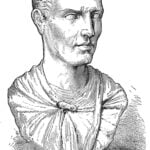During a dive in 2016 in Tel Dor (Israel), scientists came across a stone with an inscription on it. As it turned out, it had the name of a previously unknown governor of the province of Judea.
The inscription is about 1900 years old and was found at the bottom of the Mediterranean Sea, in the Gulf of Dor. Due to the storm, the stone was moved to the shallows, where the depth of the water is barely 1.5 meters. Archaeologists decided to extract the stone from the water, expecting the coming storm and fearing that the unique find would be lost in the depths of the sea or sand.
In Roman times, Dor was an important Roman port, where even its own coins were minted. On which of them you can find inscriptions indicating the city’s rule over the waters: “Lord of the Seas”.
The foundation stone has dimensions of 70×65 cm and when it was found it was covered with numerous marine flora and fauna. According to experts, it is really lucky that the inscription has been preserved almost intact. The stone was probably the base for the statue of the governor himself. The stone has a missing inscription giving the name: Gargilius Antiquus. The inscription was in Greek and scientists believe it read:
The City of Dor honors Marcus Paccius, son of Publius, Silvanus Quintus Coredius Gallus Gargilius Antiquus, governor of the province of Judea, as well as […] of the province of Syria, and patron of the city of Dor.
According to archaeologists, the governor ruled the province just before the outbreak of the Bar Kokhba uprising. He was appointed by Emperor Hadrian between 120 and 130 CE – it is possible that he took office in 123 CE, replacing Cosonius Gallus.
His name Gargilius Antiquus suggests that he may have come from North Africa and belonged to the Velina family – nobles from what is now north-eastern Tunisia. Ancient sources indicate that he began his political career early, and in 115 CE he took the post of governor of the province of Arabia. Young politicians who had the “honour” of managing a barbarian province were usually of equestrian origin. Said Arabia was just such a barbaric province.
It is hard to say for how long Gargilius Antiquusruled Judea; however, it can be said that his career enjoyed recognition, as he soon became, with the rank of the proconsul, the governor of Syria and Palestine, and around 135 CE Asia – which was proof of the appreciation of its strong position.
The foundation stone is only the second of its kind to mention the province of Judea; another is Pilate’s stone discovered in 1961.
The artifact will be on display at the Haifa University Library in Haifa (Israel).







